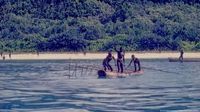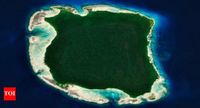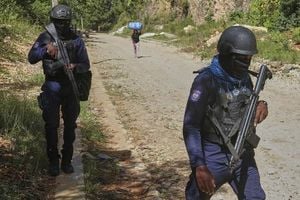Tucked away in the shimmering waters of the Bay of Bengal, North Sentinel Island stands as a tantalizing enigma—a mysterious land for the rest of the world. Home to the Sentinelese, one of the last uncontacted tribes on Earth, this island is a living relic of humanity’s ancient past. Historically, not many have come back alive from their visit to North Sentinel Island, except for a very lucky group of Indian scientists in the early 90s. It’s a place no outsider can visit, as the Indian government has draped it in a protective veil, enforcing a strict ban on visitors.
The Sentinelese people exist without knowing what the world looks like outside their island. They don’t know what AI is or that the world recently came out of a pandemic! It is estimated that there may be less than 500 islanders residing in North Sentinel Island. The Sentinelese have lived in near-complete isolation for an estimated 60,000 years, shielded from the diseases that have shaped the modern world. Their immune systems, unexposed to common pathogens like flu or measles, are uniquely vulnerable. Historical encounters, like the 1880 British expedition when abducted islanders fell ill and died in Port Blair, demonstrate the devastating potential of outside contact. A single visitor carrying a cold could unleash an epidemic, threatening the tribe’s very existence.
The ban, enshrined in the Andaman and Nicobar Islands Protection of Aboriginal Tribes Regulation of 1956, prioritizes their survival by keeping outsiders at least five nautical miles away. Interestingly, the Sentinelese have a well-documented history of rejecting intruders with lethal force. Armed with bows, arrows, and spears, they’ve attacked approaching boats, helicopters, and individuals who dared breach their shores. In 2006, they killed two fishermen whose boat drifted too close, and in 2018, American missionary John Allen Chau met a similar fate after illegally attempting to evangelize.
Recently, an incident has reignited discussions about the safety of the Sentinelese and the consequences of unauthorized visits. Mykhailo Viktorovych Polyakov, a 24-year-old American tourist, allegedly set foot on the highly restricted North Sentinel Island in a bid to interact with the reclusive tribe. Reports suggest he filmed his brief visit and left a can of Coke and a coconut on the island’s shore. The incident has drawn sharp criticism from Survival International, an organization dedicated to protecting the rights of Indigenous communities, warning that such encounters not only endanger the individual involved but also put the health and survival of the uncontacted tribe at serious risk, given their vulnerability to outside diseases.
Polyakov was arrested on March 31, 2025, after authorities discovered his attempt to interact with the tribe. Equipped with a GoPro camera, he recorded the process, offering the natives a coconut and a can of Diet Coke. According to Indian authorities, Polyakov’s journey into the Andaman Islands was meticulously planned. He studied the tides and sea conditions and set sail aboard an inflatable boat around 1 am local time on March 29. Traveling for 25 miles, he arrived at North Sentinel by 10 am and blew a whistle for an hour to draw the tribe’s attention before stepping onto their land.
“This person’s actions not only endangered his own life, but they put the lives of the entire Sentinelese tribe at risk,” said Caroline Pearce, director of Survival International. “His actions were reckless and idiotic.” The Sentinelese tribe consists of an estimated 150 members and has lived in isolation for thousands of years, lacking immunity to most common diseases. Outside contact—especially from a foreigner like Polyakov—could introduce deadly pathogens, potentially creating a chain reaction that could wipe the entire tribe out of existence.
India's laws punish unauthorized entry to North Sentinel with three to five years in prison. After being arrested, Polyakov was presented before the local court and is currently on a three-day remand for further questioning. Authorities are also trying to determine whether any locals were paid or assisted him in reaching the island, as such aid is also punishable under Indian law.
Polyakov is not the first outsider to attempt contact with the Sentinelese. In 2018, American missionary John Allen Chau, who was just two years older than Polyakov at 26, was killed by the tribe after attempting to introduce them to Christianity. Chau arrived on the island on November 15 of that year, believing it to be “Satan’s last stronghold on Earth.” He paid two fishermen to get him to the island’s shore and attempted to communicate with the natives, offering them gifts, but was met with ridicule and a steel-pointed arrow, which pierced his Bible. The missionary met his end two days later, with the fishermen reportedly seeing the tribe dragging his body.
North Sentinel Island remains a paradox: a place of breathtaking beauty and profound mystery, yet one where the price of curiosity can be death. Its prohibition is a testament to a delicate balance—protecting a fragile people, honoring their fierce independence, and preserving a slice of Earth’s ancient heritage. The Indian government’s prohibition ensures the very few remaining population of this island—untouched by globalization—remains intact. The Sentinelese are a secluded community that shuns all contact with the outside world and has been known to throw spears at anyone who comes close.
In summary, the ongoing debates surrounding North Sentinel Island highlight the complexities of Indigenous rights, the dangers of contact with uncontacted tribes, and the ethical responsibilities of outsiders. As the world continues to change rapidly, the Sentinelese remain a poignant reminder of humanity’s diverse ways of life and the importance of respecting their choice to remain isolated.






